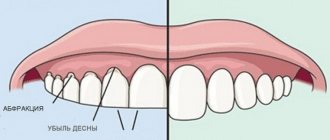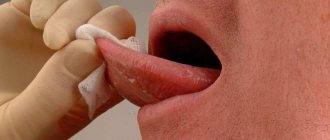Tongue cancer refers to malignant tumors of the oral cavity and oropharynx, which, in turn, are a type of head and neck cancer. This is a rare type of malignant tumor. Oral cancer accounts for about 3% of all cancers. People over 62 years of age are most often affected.
- Causes: what causes tongue cancer?
- Types of tongue cancer
- Symptoms and signs of tongue cancer
- Methods for diagnosing tongue cancer
- Stages of tongue cancer development
- Modern methods of treatment
- How long do people live with tongue cancer? What is the prognosis for recovery?
Causes: what causes tongue cancer?
Like any malignant tumor, tongue cancer occurs when genetic mutations occur in one of the cells. Because of these mutations, the cell does not respond to molecular signals and begins to multiply uncontrollably. Over time, there are so many of these “wrong” cells that they form a malignant tumor. The exact causes of tongue cancer are unknown. It is impossible to say unambiguously why genetic changes occurred in a particular cell, and it began to behave so aggressively. There are some risk factors:
- Smoking cigarettes, pipes and cigars. The risk of tongue and oral cancer in smokers is several times higher than in non-smokers, and it directly depends on the smoking experience and the daily number of cigarettes smoked. Tobacco smoke contains thousands of different substances, many of which are carcinogenic.
- Alcohol consumption. 70% of people diagnosed with malignant tumors of the tongue regularly drank alcohol. If a person smokes and often drinks alcohol, his risks increase even more: according to some data, 100 times compared to non-drinkers and non-smokers.
- Floor. According to statistics, men suffer from tongue cancer more often than women. This is probably due to the fact that they are more likely to have bad habits.
- The human papillomavirus (HPV) is transmitted through sexual contact, including oral sex. More than 150 types of pathogen are known. 13 of them can cause cancer.
- HPV type 16 is associated with malignant tumors of the mouth. Recently, the prevalence of oral and throat cancer in non-drinkers and non-smokers has been increasing, and human papillomavirus infection is often detected in them.
- Age. Most often, people over 55–60 years old get tongue cancer. But HPV-related tumors are usually found in younger people.
- Nutritional features. Some studies have shown that people whose diets are low in vegetables and fruits get sick more often.
- Weakened immunity. At increased risk are people suffering from AIDS and immunodeficiency conditions caused by other reasons.
None of these factors leads to malignant tumors of the tongue with one hundred percent probability. Their presence only means that a person has increased risks.
The role of such factors as rinsing the mouth with liquids with a high content of certain substances, irritation of the mucous membrane with dentures, and chronic inflammation in the oral cavity has not been proven. More research is needed to assess whether there are any risks in these cases.
Candidal stomatitis
Many are accustomed to thinking that stomatitis caused by the Candida fungus virus makes itself felt only through ulcers and rashes that appear on the gums and palate. But in fact, its main symptom is a dense whitish or grayish coating of curd consistency on the tongue. If you try to remove such plaque, you will find blisters underneath that itch, hurt, and bleed. As a rule, small blisters are found around the perimeter of the tongue.
The photo shows candidal stomatitis
Often the disease is provoked not only by weakened immunity, dysbiosis and long-term use of antibiotics, but also by the presence of advanced dental pathologies and lack of proper oral hygiene.
Types of tongue cancer
In 90% of cases, malignant tumors are represented by squamous cell carcinoma of the tongue. It develops from the cells of the mucous membrane that lines the surface of the tongue and the oral cavity.
The human tongue anatomically consists of two parts. The front two thirds are called the body of the tongue, the back third is called the root. Malignant tumors of the body are classified as oral cancer. They are usually easy to notice and diagnose early. Tumors of the root of the tongue are cancer of the oropharynx. He remains asymptomatic for a very long time. Often it can be diagnosed at a stage when there are already metastases in the lymph nodes of the neck.
Symptoms and signs of tongue cancer
The first symptom of tongue body cancer is most often an ulcer that does not heal for a long time and begins to bleed easily when a person bites it with his teeth or eats solid food. Malignant tumors of the root of the tongue can manifest themselves in the form of pain in the tongue and surrounding tissues, changes in voice, difficulty swallowing, and a feeling of discomfort, as if something is blocking the throat.
Other symptoms of tongue cancer in men and women that require immediate medical attention:
- A red or white spot on the mucous membrane that persists for a long time.
- Pain while swallowing.
- An unclear “bump” or swelling on the side or tip of the tongue.
- Feeling of numbness in the mouth.
- Bleeding from the tongue for no apparent reason.
- In rare cases, ear pain may be bothersome.
Many other, less dangerous pathologies can manifest similar symptoms. In order to find out an accurate diagnosis and rule out tongue cancer, you need to visit a doctor and get checked.
Book a consultation 24 hours a day
+7+7+78
What not to do
If you notice a tumor on the root of your tongue, you should never touch it. This can lead to trauma to the tumor and serious complications.
If the lump looks like a purulent pimple or cyst, there is no need to try to puncture it and squeeze out the contents. This will cause infection. Only a doctor can open abscesses on the tongue under sterile conditions.
What to do if your tongue hurts? Many neoplasms are accompanied by unpleasant sensations and discomfort. Before visiting a doctor, you can rinse your mouth with a decoction of chamomile, sage or oak bark. This will help reduce pain. You can also use the anti-inflammatory gel Metrogyl Denta. However, these are temporary measures. Only a specialist can prescribe complete treatment.
Methods for diagnosing tongue cancer
Doctors recommend that every person regularly examine their oral cavity using a mirror. Any strange sores, spots, or bumps should be a reason to visit a doctor. You need to have regular dental checkups.
If a malignant tumor of the oral cavity and oropharynx is suspected, the examination begins with an examination by a doctor. The doctor examines the oral cavity, pharynx (pharyngoscopy), larynx (laryngoscopy), and palpates the subcutaneous lymph nodes. If formations resembling cancer are found on the tongue, a biopsy is performed: a fragment of pathologically altered tissue is obtained and sent to the laboratory for microscopic examination. It is imperative to test for human papillomavirus.
If an oncological disease is diagnosed based on a biopsy, it is necessary to assess how far the cancer has spread in the body: whether the tumor has grown into neighboring organs, whether there are foci in regional lymph nodes, or distant metastases. The following diagnostic methods help with this:
- CT scan;
- chest x-ray;
- Magnetic resonance imaging;
- positron emission tomography;
- X-ray contrast studies.
First aid
Blisters on the tongue cannot be ignored. If a rash is detected, you must contact a medical facility for examination and consultation with a doctor.
If it is not possible to visit a therapist, then to alleviate the patient’s condition, it is recommended to take the following measures:
- Rinse . The use of antiseptics Miramistin and Chlorhexidine is allowed. It is possible to disinfect neoplasms that appear on the root of the muscular organ with Furacilin solution. It is also recommended to rinse your mouth with decoctions of medicinal herbs (calendula, chamomile). The frequency of procedures is at least 3-4 times a day. A blister on the tongue (both on the body of the muscular organ and near the throat) is treated with concentrated solutions of soda or a mixture of soda and salt.
- Use of an antifungal drug . Blisters found on the tongue during candidal stomatitis are advised to be treated by using the medication Nystatin.
- Use of painkillers .
Dentists recommend regularly cleaning the surface of the oral cavity from accumulated plaque using a special tool (scraper). At the end of the manipulation, it is necessary to thoroughly massage the body of the tongue with a soft-bristled toothbrush.
Additional ways to reduce pain and irritation of the mucous membranes in the presence of small white blisters are complete abandonment of bad habits and a strict diet.
Traditional medicine recommends treating red blisters with infusions of sage and oak bark.
After removing the acute symptoms of the disease and alleviating the general condition of the patient, you should contact a medical clinic specialist who will advise the necessary treatment regimen, taking into account the severity of the disease and the frequency of exacerbations.
Stages of tongue cancer development
The doctor determines the stage depending on the size of the primary tumor, its growth into neighboring tissues, the presence of lesions in regional lymph nodes and distant metastases. The classifications of body and root of tongue cancer are slightly different:
| Stage | Tongue body cancer | Tongue root cancer |
| Tongue cancer stage 1 (I) | The largest diameter of the tumor is 2 cm or less. | |
| Tongue cancer stage 2 (II) | The largest diameter of the tumor is more than 2 cm but less than 4 cm. | |
| Tongue cancer stage 3 (III) | One of the following signs:
| |
| Tongue cancer stage 4A (IVA) | One of the following signs:
| One of the following signs:
|
| Tongue cancer stage 4B (IVB) | One of the following signs:
| |
| Tongue cancer stage 4 °C (IVC) | It does not matter the size of the primary tumor, or whether there are lesions in the regional lymph nodes. If distant metastases are found, stage IVC is always diagnosed. | |
Modern methods of treatment
Approaches to the treatment of malignant tumors of the body and root of the tongue are somewhat different.
Treatment of tongue body cancer
If the tumor is less than 4 cm in size, it is removed surgically. In some cases, removal of regional lymph nodes is also indicated. Usually no other treatment is required.
Typical tactics for advanced cancer of the body of the tongue (the tumor is more than 4 cm or has managed to grow strongly into the surrounding tissues) involves a combination of three treatment methods:
- Surgical removal of the primary tumor, as well as regional lymph nodes.
- Radiation therapy. Before carrying out it, a consultation with a dentist and sanitation of foci of infection in the oral cavity are required.
- Chemotherapy.
In case of relapse, as well as in the last stage of tongue cancer with distant metastases, chemotherapy becomes the main treatment method.
Treatment of cancer of the base (root) of the tongue
If the tumor diameter is less than 4 cm, it is removed, and regional cervical lymph nodes are also excised. If the risk of relapse is high, radiation therapy to the neck area or chemoradiotherapy (radiation combined with chemotherapy) is prescribed after surgery.
If the tumor is larger than 4 cm or has grown into surrounding tissues, different treatment options are possible:
- chemoradiotherapy;
- removal of part of the tongue and surrounding tissues, regional lymph nodes, followed by a course of chemotherapy or radiation therapy;
- only radiation therapy.
The type of surgery for cancer of the body and root of the tongue depends on the location of the tumor, its size and the degree of invasion of surrounding tissue. Chemotherapy or radiation therapy may complement surgery. When used as a stand-alone treatment, they are usually prescribed for palliative purposes. They will not completely destroy cancer, but will help slow its progression, improve the patient’s condition, and prolong life.
In some cases, the targeted drug cetuximab (Erbitux) and the immunodrug nivolumab are prescribed.








